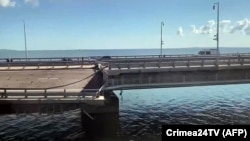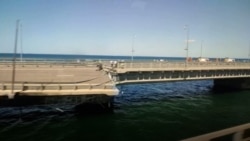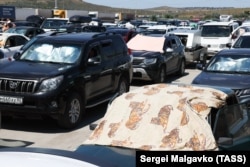Officials in Moscow and in occupied Crimea have been quick to say that the July 17 explosion that damaged the only bridge linking Russia to the Black Sea peninsula was not serious and that rail and road traffic over the bridge would be quickly restored. Russian Deputy Prime Minister Marat Khusnullin asserted that the structure's supporting pylons had not been damaged and that the bridge would be completely repaired by November 1.
Nonetheless, the attack struck a key logistical route supplying Russian military forces not only on the Crimean Peninsula but across southern Ukraine, where Kyiv is carrying out a counteroffensive to claw back territory that Russia has occupied since the first weeks of its unprovoked full-scale invasion in February 2022.
“The Crimea Bridge is the main logistical link,” said Pavlo Lakiychuk, a military analyst at the Kyiv-based think tank Strategy XXI. “Even if the railroad bridge was, say, closed for six hours or so and shipping traffic was shut down for a similar period of time, that is a six-hour break for our troops who will have fewer shells raining down on them. That is a plus.”
Lakiychuk dismissed Russian President Vladimir Putin’s claim on July 17 that the bridge “has long not been used” for military transport.
“The bridge has been and remains one of the main supply arteries for supplying Russian forces across southern Ukraine, including in Crimea,” he said. “Including those who are defending themselves from the attacks of our forces in the Kherson and Zaporizhzhya regions.”
The bridge, he said, is used to supply heavy equipment, ammunition such as artillery shells, fuel, and other crucial, ongoing needs of Russian forces in Ukraine.
“Delaying [these supplies] for an hour or two or three or six or 12 is a vital matter for our troops, who are engaged in heavy fighting,” Lakiychuk said.
“The river of military supplies for Russia has slowed to a trickle,” he concluded.
Andriy Yusov, the spokesman for Ukraine’s Main Intelligence Directorate (HUR), offered a similar assessment on July 17, saying: “Any logistical problems are one more complication for the occupiers that creates a potential advantage for Ukrainian defense forces.”
Khusnullin, the Russian deputy prime minister who was put in charge of the repair works, wrote on Telegram early on July 18 that one lane of the bridge had been reopened for vehicle traffic.
Immediate Impact
The damage to the bridge also had an immediate impact for civilians in Crimea. Supplies of food and other essentials via the bridge were halted at least temporarily, and Russian occupation authorities warned that it could be days before truck traffic is restored. Trucks were being diverted to ferries, which can be unpredictable due to frequent high winds on the strait. This month, before the attack, truckers were already reporting that inspections and the ferry transit took around three hours.
When explosions were heard in the city of Kerch at the Crimea end of the bridge on July 9, de facto officials had to quickly calm people by reporting that the bridge was not targeted.
“People in Crimea are right to worry about the Kerch bridge because transit through Russian-occupied Ukrainian territory is not safe,” Lakiychuk said.
The news outlet Kerch.fm reported in June that truck drivers were refusing to travel between Russia and Crimea via the occupied parts of southern Ukraine along the Sea of Azov coast out of safety concerns and were insisting on higher pay for coping with the delays at the ferries.
“Because of the hours-long waits in line for the ferry, they are demanding ‘waiting fees,’” the website quoted an employee at a Crimean butcher shop as saying. “Drivers either do not want to go to Crimea or they are charging double to do so.”
Increasingly, Crimea resembles a war zone, and the peninsula has been targeted by a mounting number of drone and other attacks in 2023. The occupation authorities have undertaken a massive program of building trenches and other fortifications. However, Ukrainian military analyst Mykhaylo Prytula, a retired army colonel, told RFE/RL that Kyiv’s strategy is to isolate the peninsula as much as possible.
“At some point, Crimea will simply be an island without any connection to the mainland or via the Kerch bridge,” he said. “Imagine a Crimea without water. Without military supplies…. All that will be working will be the airports and the ports. Car traffic will be closed, and people will not be able to evacuate their possessions.”
“At that point, the only choice will be to surrender or to flee,” Prytula said.
The 19-kilometer Crimea Bridge, which facilitates both automotive and rail traffic, was completed in May 2018 at a cost of some $4 billion. It was a significant prestige project intended to bolster Moscow’s claim to Ukraine’s Crimea region that was inaugurated by Putin in person.
Kyiv has not claimed responsibility for the blast -- the second attack to do substantial damage to the bridge in 10 months -- but Ukrainian media reported that security services had deployed two maritime drones to carry out the operation.
Lakiychuk said that could signal a significant technological breakthrough for Kyiv. Ukraine, he said, only began developing sea-based drones after Russia’s February 2022 invasion and the work has been carried out “under wartime conditions.”
“If this is so, the Russian side wasn’t ready for the Ukrainian military’s capability of using such drones so far away from its military bases,” he said.
Crimea Becoming A Frontline Zone?
He added that such operations generate valuable information for Ukrainian intelligence services that makes future operations more likely to succeed.
“Intelligence will have a lot of work now,” Laviychuk said.
The July 17 blast followed a major explosion and fire in October 2022 that prevented the full operation of the bridge for months. Lakiychuk said the fact that bridge spans collapsed in both cases could indicate that the foundation of the structure has vulnerabilities.
“If the spans are falling, that means that the supports beneath them are shifting,” he said.
The explosion, which Russia said killed a married couple in a car and injured their 14-year-old daughter, will likely reinforce the growing impression that Crimea is a “frontline zone,” to use the formulation of Refat Chubarov, the Kyiv-based president of the Worldwide Congress of Crimean Tatars and chairman of the Mejlis of the Crimean Tatar People, a self-governing body that Russia declared illegal after occupying the peninsula in 2014.
After the October 2022 explosion on the bridge, Russia was forced to intensify security checks and other measures for traffic moving in both directions, Chubarov told RFE/RL on June 30, before the most recent blast, causing alarm and frustration for travelers.
“These measures will continue as long as the bridge stands, until it is destroyed by Ukrainian rockets,” he said. “I think that will happen soon.”














